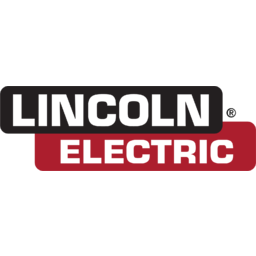
P/E ratio for Lincoln Electric (LECO)
P/E ratio as of April 2024 (TTM): 27.6
According to Lincoln Electric 's latest financial reports and stock price the company's current price-to-earnings ratio (TTM) is 27.5901. At the end of 2022 the company had a P/E ratio of 17.8.
P/E ratio history for Lincoln Electric from 2001 to 2023
PE ratio at the end of each year
| Year | P/E ratio | Change |
|---|---|---|
| 2022 | 17.8 | -40.62% |
| 2021 | 29.9 | -11.44% |
| 2020 | 33.8 | 64.9% |
| 2019 | 20.5 | 15.14% |
| 2018 | 17.8 | -26.92% |
| 2017 | 24.4 | -6.6% |
| 2016 | 26.1 | -14.06% |
| 2015 | 30.3 | 41.43% |
| 2014 | 21.5 | 7.97% |
| 2013 | 19.9 | 26.55% |
| 2012 | 15.7 | 4.77% |
| 2011 | 15.0 | -29.27% |
| 2010 | 21.2 | -54.02% |
| 2009 | 46.1 | 350.64% |
| 2008 | 10.2 | -32.04% |
| 2007 | 15.0 | 2.37% |
| 2006 | 14.7 | 8.24% |
| 2005 | 13.6 | -22.53% |
| 2004 | 17.5 | -6.45% |
| 2003 | 18.7 | -44.14% |
| 2002 | 33.6 | 169.06% |
| 2001 | 12.5 |
P/E ratio for similar companies or competitors
| Company | P/E ratio | P/E ratio differencediff. | Country |
|---|---|---|---|
 Illinois Tool Works ITW | 24.1 | -12.78% | 🇺🇸 USA |
 Stanley Black & Decker
SWK | -223 | -909.35% | 🇺🇸 USA |
 Hurco Companies HURC | 37.1 | 34.59% | 🇺🇸 USA |
 Colfax Corporation CFX | 27.1 | -1.69% | 🇺🇸 USA |
 Kennametal KMT | 16.1 | -41.77% | 🇺🇸 USA |
How to read a P/E ratio?
The Price/Earnings ratio measures the relationship between a company's stock price and its earnings per share. A low but positive P/E ratio stands for a company that is generating high earnings compared to its current valuation and might be undervalued. A company with a high negative (near 0) P/E ratio stands for a company that is generating heavy losses compared to its current valuation.
Companies with a P/E ratio over 30 or a negative one are generaly seen as "growth stocks" meaning that investors typically expect the company to grow or to become profitable in the future.
Companies with a positive P/E ratio bellow 10 are generally seen as "value stocks" meaning that the company is already very profitable and unlikely to strong growth in the future.